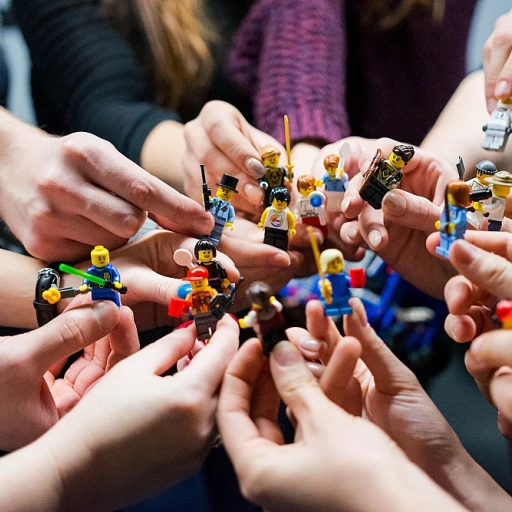
Understanding Interpersonal Tact
Delving into the Essence of Interpersonal Tact
Interpersonal tact is more than just a fancy term tossed around in leadership courses or military training among army leaders and nco. It's a critical skill that encompasses the ability to navigate social interactions with grace, poise, and sensitivity. Tact is the linchpin that holds together effective communication, allowing leaders to manage difficult situations with diplomacy and respect.
To illustrate, in an army leadership context, interpersonal tact involves striking the right balance between transparency and discretion. This balance ensures successful communication without compromising the dignity or privacy policy considerations of team members. For those invested in continuous learning, be it in the army or civilian spheres, mastering interpersonal tact is pivotal.
Understanding interpersonal skills and communication skills in a learning environment can be challenging, yet essential for creating a harmonious organizational culture. With effective verbal communication, leaders can inspire their teams to work effectively, leverage the full spectrum of available resources, and navigate the complexities of united states army leadership.
For those eager to hone their communication and emotional intelligence skills, engaging in relevant training programs or online courses can be incredibly beneficial. Such training programs aim to equip future leaders with the tactful communication skills needed to lead with empathy and effectiveness.
Operating within a dynamic learning environment, understanding interpersonal tact serves as a compass, guiding leaders and team members toward a path of collaborative success. If you're keen to explore this concept further within the spectrum of continuous growth, consider exploring resources available at the bwc learning center.
The Role of Interpersonal Tact in Learning Environments
The Influence of Tactful Communication on Learning Spaces
Interpersonal tact, with its roots firmly planted in the principles of effective communication and emotional intelligence, plays a crucial role in fostering a productive learning environment. In settings ranging from army training programs to civilian education, the presence of a tactful leader can significantly transform the dynamics of a team or classroom.
Successful leaders understand that interpersonal skills are as vital as technical skills. A tactful approach involves diplomacy, sensitivity, and the ability to listen actively. These skills help navigate difficult situations with grace, ensuring that team members feel valued and heard. For instance, army leadership places high importance on these skills to maintain unit cohesion and operational effectiveness, recognizing that understanding and addressing the diverse needs of NCOs (non-commissioned officers) and soldiers is vital to mission success.
In educational settings, teachers and trainers who display tact in their interactions create an atmosphere where students are more inclined to express themselves openly. This open line of communication promotes deeper engagement and encourages active learning. The ability to convey information clearly and respectfully helps prevent misunderstandings, paving the way for cooperation and collaboration.
Cultivating Effective Relationships within Teams
Interpersonal tact aids in building effective relationships within any group or organization. By promoting a culture of respect and understanding, it becomes easier to handle disruptions or conflicts that may arise. This capability is particularly important in diverse groups, where varied experiences and cultural backgrounds can lead to different perspectives.
Training programs focusing on enhancing communication skills are invaluable. These programs equip participants with the tools needed to practice tactful communication. Online courses focused on leadership development often emphasize the importance of tact and diplomacy as key components of leadership skills. As explained further in rational thinking within continous learning, incorporating rational understanding into communication strategies can enhance decision-making processes.
Ultimately, the role of interpersonal tact in learning environments cannot be overstated. It serves as the underpinning for constructive interactions, empowers individuals to contribute to their fullest potential, and lays the foundation for successful educational outcomes.
Developing Interpersonal Tact Skills
Enhancing Your Interpersonal Abilities
Developing interpersonal tact skills is crucial for effective communication and leadership in any learning environment. Interpersonal tact involves a combination of emotional intelligence, diplomacy, and adaptability, allowing individuals to navigate complex social interactions with ease. These skills are invaluable for army leaders, educators, and team members who must work harmoniously to achieve common goals.
To enhance your interpersonal skills, consider the following strategies:
- Engage in Active Listening: Actively listening to others helps build rapport and understanding. This means paying full attention, asking clarifying questions, and paraphrasing what has been said to ensure comprehension.
- Practice Tact Diplomacy: Tactful communication involves being sensitive to others' feelings and perspectives. This is particularly important for leaders who must address difficult situations without alienating team members.
- Develop Emotional Intelligence: Understanding and managing your emotions, as well as empathizing with others, enhances your ability to navigate interpersonal dynamics successfully.
- Participate in Training Programs: Consider enrolling in online courses or training programs focused on communication skills and leadership development, such as those offered by the army or NCO leadership programs.
- Foster a Positive Organizational Culture: Encouraging open communication and collaboration within teams promotes effective working relationships and supports continuous learning.
By honing these skills, you can improve your ability to communicate effectively, make better use of available resources, and lead with confidence. Enhancing your capacity for tact leadership not only benefits your relationships with team members but also contributes to the overall success of your learning environment.
Overcoming Challenges in Interpersonal Communication
Addressing Barriers in Tactful Interactions
Developing effective interpersonal tact within learning environments can be challenging, but it’s essential for successful communication and leadership, particularly in settings like army leadership and organizational training programs. Leaders often face difficult situations that test their communication skills and ability to maintain a tactful presence.
The challenges often arise from differing communication styles among team members. Effective communication requires patience, active listening, and an understanding of emotional intelligence, which are critical components in fostering a cohesive team. Leaders need to be equipped with diverse communication skills to address these hurdles.
Enhancing Communication Through Training
A well-structured training program focused on interpersonal skills, including courses on tact diplomacy and verbal communication, can be instrumental in overcoming these barriers. Training programs, such as those used by army leaders, offer valuable resources for cultivating communication skills that are applicable in both professional and academic environments.
Participants in such programs gain insight into the nuances of interpersonal tact, better preparing them to navigate the complexities of group dynamics effectively. This understanding is crucial for maintaining productive interactions and ensuring that communication remains open and effective.
Leveraging Tact in Diverse Environments
In diverse learning groups, where learners come from various backgrounds, leaders must employ tact diplomacy to address unique cultural perspectives and communication barriers. Acknowledging and respecting these differences through tactful communication helps create an inclusive environment conducive to learning.
By focusing on the development of tact leadership and interpersonal skills, leaders can better integrate diverse viewpoints into the learning process. This approach not only enhances the quality of communication but also enriches the learning experience for all participants.
In conclusion, overcoming challenges in interpersonal communication through training and a commitment to developing tactical skills enhances the learning experience. Through effective leadership and tactful interactions, leaders can ensure that all team members are equipped to engage successfully in continuous learning environments.
Interpersonal Tact in Diverse Learning Groups
Practicing Diplomacy in Diverse Learning Groups
In the realm of continuous learning, the ability to practice tact—both as a leader and a team member—plays a pivotal role in navigating diverse environments. Tact, as part of effective communication, becomes even more essential when working with individuals from different backgrounds, perspectives, and cultures. These dynamics are crucial within various organizations, including the army, where leadership and teamwork are fundamental. To engage effectively in diverse learning groups, one must develop a set of key communication skills. This isn't solely about verbal communication; it's about understanding the subtle cues and cultural nuances that may impact interactions. Emotional intelligence becomes critical here, allowing individuals to understand and respond to the emotional cues of others appropriately.Key Strategies for Successful Interaction
- Acknowledge Differences: Respect for varied perspectives helps foster a nurturing environment where all team members feel valued and understood.
- Facilitate Open Dialogue: Create opportunities for open communication, where everyone feels safe to express their thoughts and ideas freely. This applies in both training and real-world scenarios.
- Cultivate Trust through Transparency: Transparency and honesty in communication build trust, enhancing the group's overall effectiveness.
Training and Development
Organizations ought to implement training programs that hone these interpersonal skills. By offering courses that emphasize tactful communication and interpersonal relationship management, they pave the path for sustained success. These initiatives should aim to provide the resources necessary for overcoming difficult situations with grace and competence. As future trends continue to shape the learning landscape, the emphasis on diversity and inclusion within training programs will grow. Leaders must be prepared not only to adapt to these changes but to actively promote a culture where tact diplomacy thrives. This not only enhances personal development but also drives better learning outcomes across various environments.The Impact of Interpersonal Tact on Learning Outcomes
Enhancing Learning Outcomes through Interpersonal Tact
In the realm of continuous learning, the ability to apply interpersonal tact can significantly influence the effectiveness of training programs and learning environments. Leaders who master tactful communication can navigate difficult situations with ease, fostering a culture of open dialogue and mutual respect. This is particularly evident in environments like the army, where leadership and communication skills are crucial.
Interpersonal tact involves more than just verbal communication. It encompasses emotional intelligence and the ability to read non-verbal cues, which are essential for effective communication. These skills enable leaders to connect with team members on a deeper level, promoting a sense of unity and collaboration. This is especially important in diverse learning groups where varying perspectives and backgrounds can enrich the learning experience.
Successful leaders recognize the value of tact diplomacy in creating a supportive learning atmosphere. They understand that fostering a sense of belonging and respect within the team can lead to more effective training outcomes. This is not only beneficial for the learners but also enhances the overall organizational culture.
Moreover, the application of interpersonal tact in learning environments can lead to more efficient use of resources. By addressing and resolving conflicts diplomatically, leaders can ensure that training programs run smoothly, without unnecessary disruptions. This approach is aligned with the principles of army leadership, where maintaining harmony and cohesion within the team is paramount.
As continuous learning evolves, the importance of interpersonal tact will only grow. Future trends in training programs will likely emphasize the development of these skills, ensuring that leaders are well-equipped to handle the challenges of an ever-changing learning landscape. Effective communication, both verbal and non-verbal, will remain at the core of successful learning outcomes, making interpersonal tact an indispensable asset for any leader.












